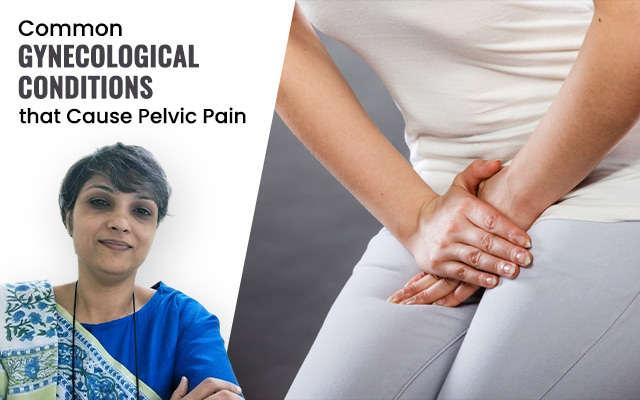Pelvic pain is the most common problem experienced by women. This can be caused by various gynecological issues. Understanding the underlying conditions can help you get the most effective treatment and address pelvic pain. Know more below.
Gynecological Conditions that Cause Pelvic Pain
Some of the most common gynecological conditions that cause pelvic pain are the following.
- Endometriosis: When a tissue similar to the uterus lining (endometrium) starts growing outside, mainly on the ovaries, fallopian tubes, or the lining of the pelvic cavity, the condition is known as endometriosis. Its symptoms like pelvic pain worsen during the time of menstruation. Besides, women suffering from endometriosis also experience painful periods, pain during sexual intercourse and lower back pain.
- Pelvic Inflammatory Disease: Pelvic inflammatory disease causes an infection of the female reproductive organs like the ovaries, fallopian tubes and the uterus. This infection is usually caused due to sexually transmitted infections like chlamydia or gonorrhea. The condition can result in chronic pelvic pain, fever, painful urination and abnormal vaginal discharge. If left untreated, pelvic inflammatory disease can lead to complications like infertility and ectopic pregnancy.
- Ovarian Cysts: Ovarian cysts are often described as fluid-filled sacs that develop on or within the ovary. Most women experience ovarian cysts in their reproductive years. And, they are usually painless. However, some ovarian cysts can result in pelvic pain when they grow large in size or when they put pressure on the surrounding structures. The pain may be sharp or sudden and may even be one-sided. It may sometimes occur during sexual intercourse or physical activity. In rare cases, ovarian cysts can result in serious complications like ovarian torsion, which warrants immediate medical attention.
- Fibroids: These are non-cancerous growths in the uterine wall. They are mostly common, and some women experience no symptoms. However, if fibroids are large enough, they may cause significant pelvic pain, heavy bleeding, frequent urination and pressure on nearby organs. The pain is usually dull or constant but can worsen during physical activity or menstruation.
- Adenomyosis: This condition occurs when the tissue that normally lines the uterus starts growing into the muscular wall of the uterus. This can lead to symptoms like chronic pelvic pain, painful periods and increased menstrual bleeding. The pain is usually described as long periods of discomfort.
Conclusion
Early diagnosis can help identify and treat the underlying cause of pelvic pain. Hence, if you experience pelvic pain along with the other aforementioned symptoms, contact Dr. Smita Jadhav, a leading gynecologist who provides chronic pain pelvic treatment in Kolkata.


